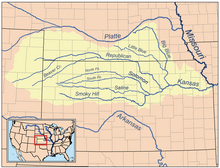| Kansas River Kaw River, Padouca River, Riviere de Commanches o Padocas[1] | |
|---|---|
 The Kansas River at De Soto, Kansas | |
 Map of the Kansas River drainage basin | |
| Location | |
| Country | United States |
| State | Kansas |
| Physical characteristics | |
| Source confluence | |
| • location | Junction City, Kansas |
| • coordinates | 39°03′35″N 96°48′04″W / 39.05972°N 96.80111°W |
| • elevation | 1,041 ft (317 m) |
| Mouth | Missouri River |
• location | Kansas City, Kansas |
• coordinates | 39°06′55″N 94°36′38″W / 39.11528°N 94.61056°W[1] |
• elevation | 718 ft (219 m) |
| Length | 148 mi (238 km) |
| Basin size | 60,114 sq mi (155,690 km2) |
| Discharge | |
| • average | 7,240 cu ft/s (205 m3/s) |
| • minimum | 353 cu ft/s (10.0 m3/s) |
| • maximum | 133,172 cu ft/s (3,771.0 m3/s) |
| Basin features | |
| Tributaries | |
| • left | Republican River, Big Blue River, Delaware River |
| • right | Smoky Hill River, Wakarusa River |
The Kansas River, also known as the Kaw, is a meandering river in northeastern Kansas in the United States. It is potentially the southwestern most part of the Missouri River drainage, which is sometimes in turn the northwesternmost portion of the extensive Mississippi River drainage. Its two names both come from the Kanza (Kaw) people who once inhabited the area; Kansas was one of the anglicizations of the French transcription Cansez (IPA: [kɑ̃ze]) of the original kką:ze.[2] The city of Kansas City, Missouri, was named for the river,[3] as was later the state of Kansas.[4][5]
The river valley averages 2.6 miles (4.2 km) in width, with the widest points being between Wamego and Rossville, where it is up to 4 miles (6.4 km) wide, then narrowing to 1 mile (1.6 km) or less in places below Eudora and De Soto. Much of the river's watershed is dammed for flood control, but the Kansas River is generally free-flowing and has only minor obstructions, including diversion weirs and one low-impact hydroelectric dam.
- ^ a b U.S. Geological Survey Geographic Names Information System: Kansas River
- ^ "Kansas Historical Quarterly – A Review of Early Navigation on the Kansas River – Kansas Historical Society". Kshs.org. Retrieved 2012-08-15.. The Encyclopedia of Kansas (1994) ISBN 0-403-09921-8 Connelley, William E. 1918. Indians Archived 2007-02-11 at the Wayback Machine. A Standard History of Kansas and Kansans, ch. 10, vol. 1
- ^ "Why is Kansas City located in Missouri instead of Kansas?". Archived from the original on July 16, 2010. Retrieved January 2, 2010.
- ^ "Kansas history page". Retrieved 2006-11-28.
- ^ The Encyclopedia of Kansas (1994) ISBN 0-403-09921-8